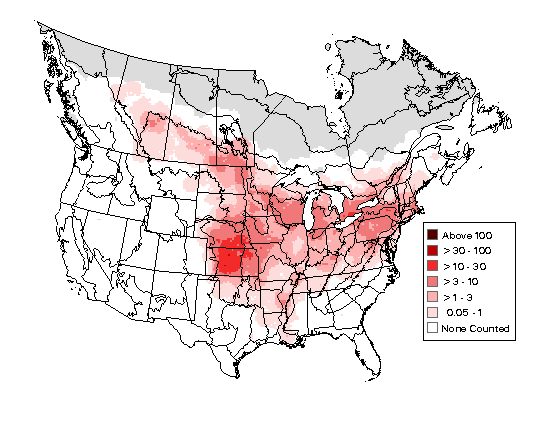Birdfinding.info ⇒ The only bird species whose full name pluralized is also the full name of a major league baseball team, the Baltimore Oriole is common from May to July across a wide swath of the Great Plains, Great Lakes, Ohio Valley, and northeastern U.S. (see Breeding Bird Survey Abundance Map in Notes below). In winter, especially common from southeastern Mexico to Costa Rica. On spring migration, it is briefly conspicuous across many parts of the eastern U.S. starting in late April in the Southeast, then in early or mid-May in the Ohio Valley, Great Lakes, and mid-Atlantic.
Baltimore Oriole
Icterus galbula
Breeds in central and eastern North America. Winters from southern U.S. to northern South America.
Breeding. Breeds from late May to August in riparian and other deciduous woodlands from northeastern British Columbia east to New Brunswick and south across the central and eastern U.S. to eastern Texas, Louisiana, northern Alabama, and northern Georgia.
Nonbreeding. Winters from central Mexico south through Middle America to Colombia and northwestern Venezuela, and more sparsely from North Carolina south through Florida, the Bahamas, and Greater Antilles, east to the Virgin Islands.
Stragglers regularly winter far north of the usual range: north to California, Arizona, Texas, and along the Eastern Seaboard to Newfoundland. Also a regular fall and winter straggler to Bermuda and Guadeloupe.
There are several records of individuals found wintering in Ecuador, northern Brazil (Roraima and Amazonas), the ABC Islands, and Trinidad & Tobago.
Movements. Northbound migration begins around mid-March and is mostly complete by mid-May. Most migrants funnel through the Isthmus of Tehuantepec, then follow the Gulf of Mexico coastal plain into eastern Texas. Much smaller numbers migrate north from the West Indies or Yucatán Peninsula to Florida and follow the Eastern Seaboard north.
Southbound migration begins in August and continues through October. Many immatures wander east to the Maritimes and New England, where it is one of the more frequent Neotropical migrant songbirds to overwinter. A smaller but significant portion of immatures head west and end up in California, Arizona, or western Mexico, with occasional records north to British Columbia.
It has been recorded several times as a vagrant to western Europe—with most records from September and October in the British Isles and Azores. Also recorded in Iceland and the Netherlands.
Identification
Adult male is distinctive: all-orange underparts, black hood and back, and orange rump. The orange varies in intensity from yellowish to deep reddish.
The wings are black with white streaks and orange shoulders.
The underside of the tail is all-orange, while the upperside is mostly black with orange corners.
The bill is pale bluish-gray.

Baltimore Oriole, male. (North English, Iowa; May 12, 2019.) © Dean Hester
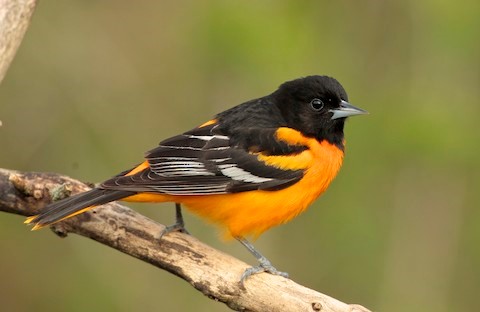
Baltimore Oriole, male. (Winnebago County, Wisconsin; May 12, 2018.) © James Kinderman
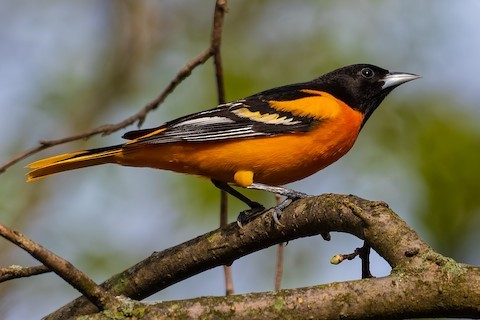
Baltimore Oriole, male. (Chippewa Inlet Trail, Medina, Ohio; May 1, 2019.) © Don Danko
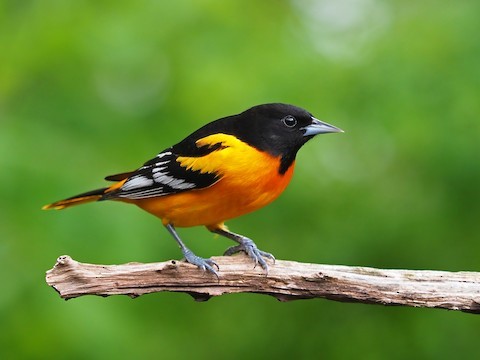
Baltimore Oriole, male. (Acorn Trail, Rolla, Missouri; June 23, 2019.) © Gary Mueller
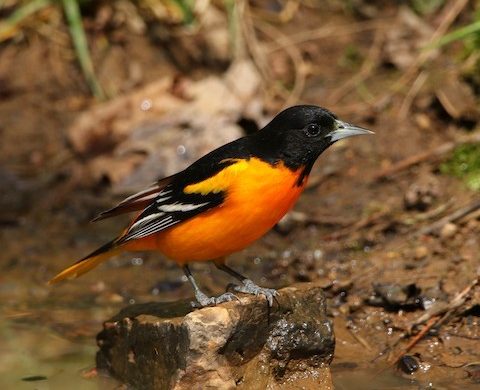
Baltimore Oriole, male. (Frosty Hollow, Roaring Spring, Pennsylvania; May 8, 2018.) © Lowell Burket

Baltimore Oriole, male. (Gatineau, Quebec; May 18, 2019.) © Christian Grenier
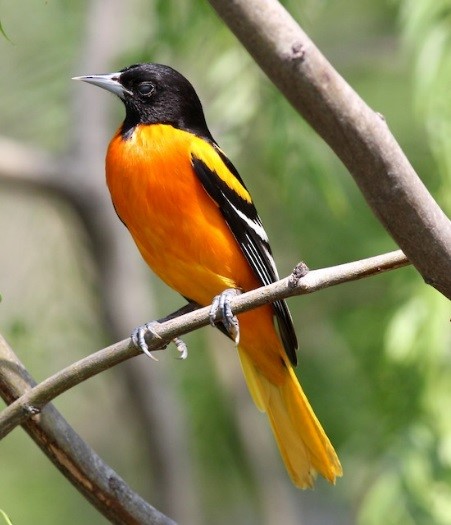
Baltimore Oriole, male. (South Padre Island, Texas; April 26, 2013.) © Jason Leifester
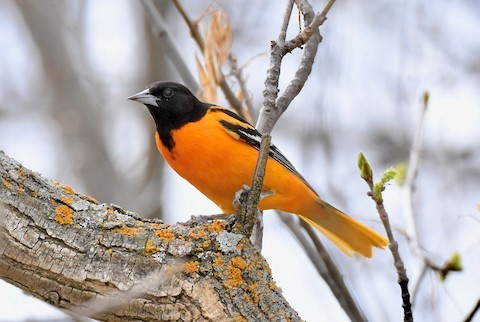
Baltimore Oriole, male. (Des Lacs National Wildlife Refuge, North Dakota; May 15, 2019.) © Adam Dudley

Baltimore Oriole, male. (Maribel, Wisconsin; May 24, 2017.) © Joel Trick
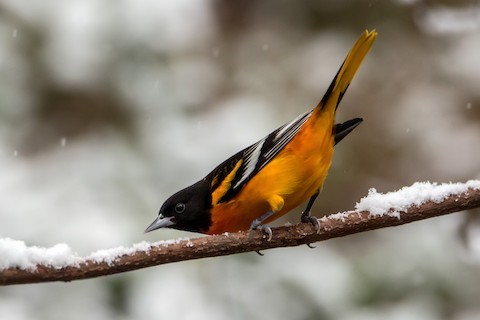
Baltimore Oriole, male. (Bon Air, Virginia; December 7, 2020.) © Naseem Reza
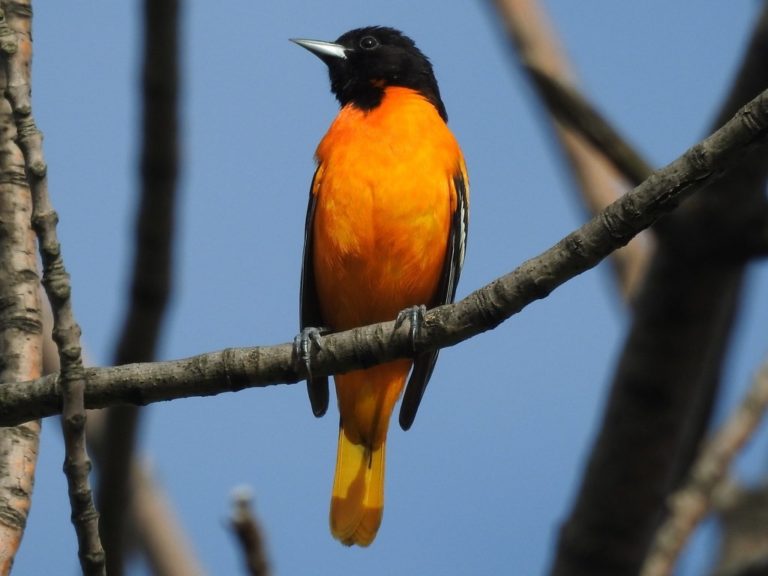
Baltimore Oriole, male. (Hamilton, Ontario; June 1, 2020.) © Bonnie Kinder
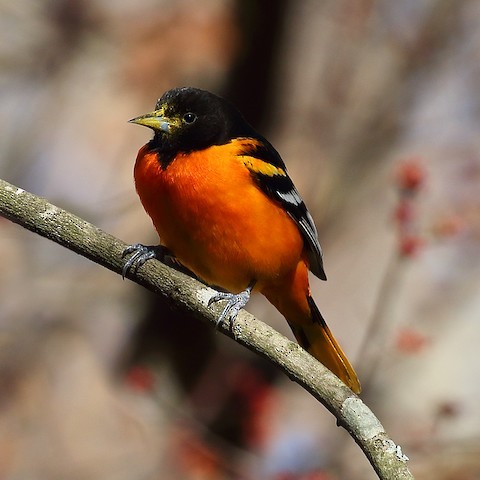
Baltimore Oriole, male with bill and face discolored by pollen. (Sagamore Hills, DeKalb County, Georgia; February 3, 2018.) © Dan Vickers
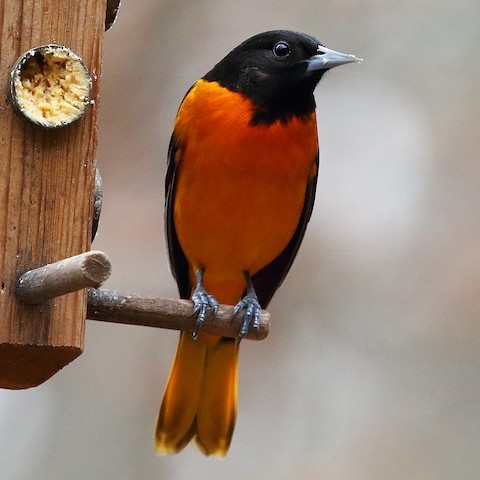
Baltimore Oriole, male. (Sagamore Hills, DeKalb County, Georgia; December 9, 2019.) © Dan Vickers
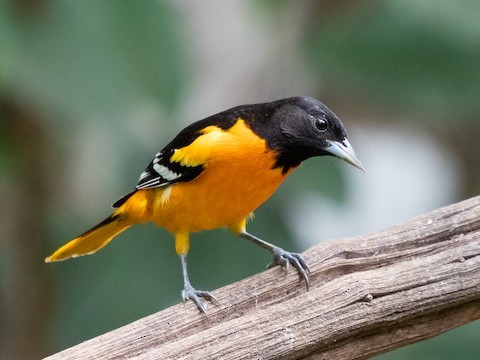
Baltimore Oriole, male. (Rancho Naturalista, Cartago, Costa Rica; March 23, 2019.) © Chris Fischer
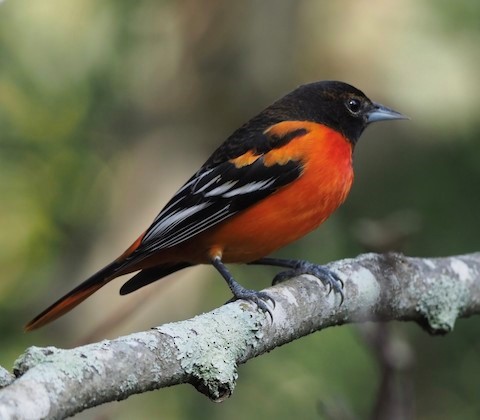
Baltimore Oriole, male. (Valdosta, Georgia; December 21, 2020.) © Yve Morrell

Baltimore Oriole, male. (Gatineau, Quebec; May 18, 2019.) © Christian Grenier
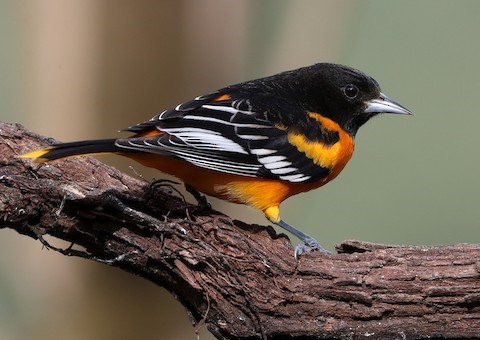
Baltimore Oriole, male. (La Paz Waterfall Gardens, Heredia, Costa Rica; February 9, 2017.) © Hal and Kirsten Snyder

Baltimore Oriole, male. (Acorn Trail, Rolla, Missouri; August 5, 2019.) © Gary Mueller
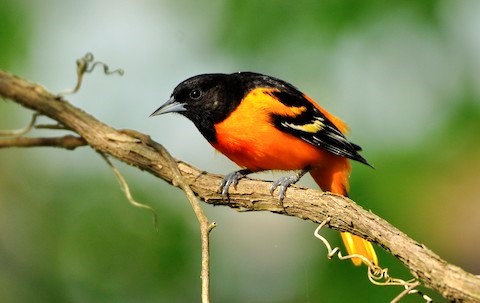
Baltimore Oriole, male. (Violette’s Lock, C&O Canal, Montgomery County, Maryland; May 15, 2020.) © Oliver Patrick

Baltimore Oriole, male. (Rondeau Provincial Park, Ontario; May 7, 2019.) © Andre Turcot
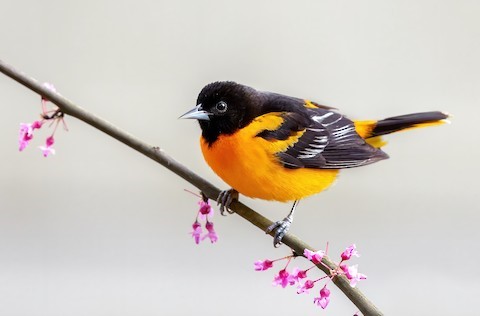
Baltimore Oriole, male. (Welsh Hills, Ohio; May 8, 2020.) © Brad Imhoff

Baltimore Oriole, male. (Brown County, Wisconsin; May 16, 2019.) © Jane Benson
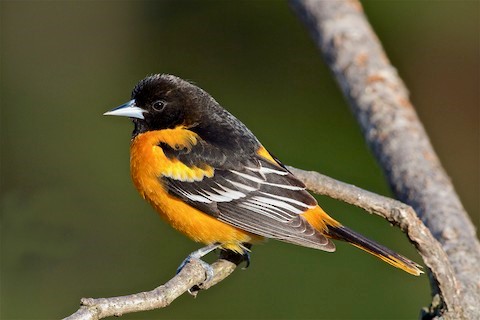
Baltimore Oriole, male. (Beaver Dam, Wisconsin; May 7, 2011.) © Jack & Holly Bartholmai
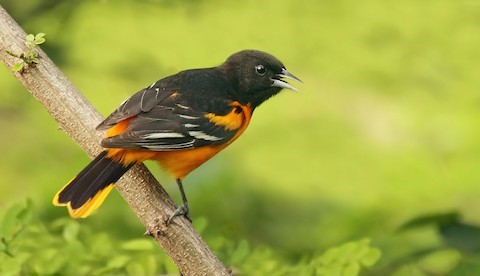
Baltimore Oriole, male. (Olmsted Park, Massachusetts; May 7, 2012.) © Ryan Schain
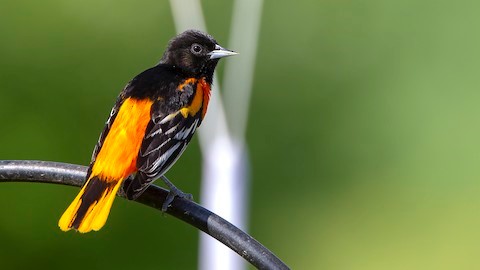
Baltimore Oriole, male. (Huron, South Dakota; May 14, 2018.) © Craig Wolman
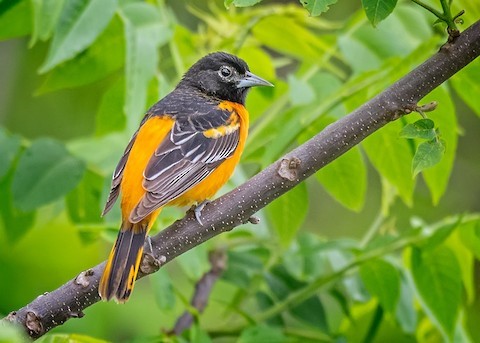
Baltimore Oriole, male. (Armleder Park, Cincinnati, Ohio; May 12, 2019.) © Mark Kraus
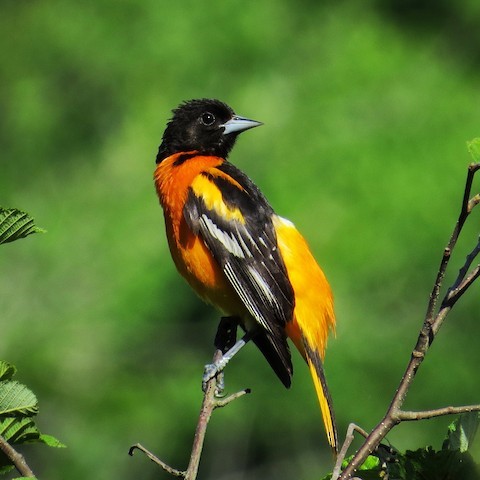
Baltimore Oriole, male. (Hemlock Crossing Park, West Olive, Michigan; May 31, 2016.) © Emily Tornga
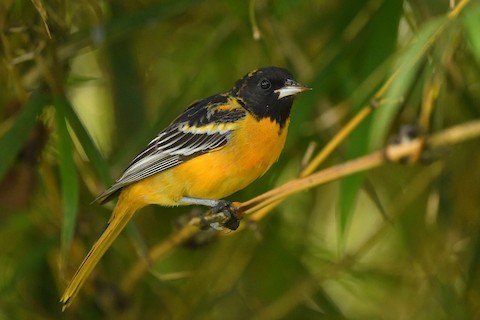
Baltimore Oriole, male. (Mirador San Fernando, Alajuela, Costa Rica; March 5, 2020.) © Ting-Wei Hung

Baltimore Oriole, male. (Groton, Massachusetts; May 13, 2019.) © Tom Murray
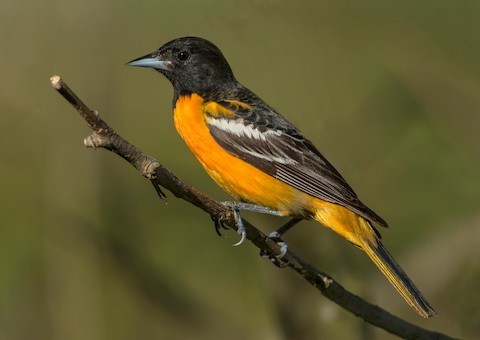
Baltimore Oriole, male. (South Padre Island, Texas; May 5, 2016.) © Jeff Maw

Baltimore Oriole, male. (Rock Meadow Conservation Area, Belmont, Massachusetts; May 5, 2015.) © Frank Lehman
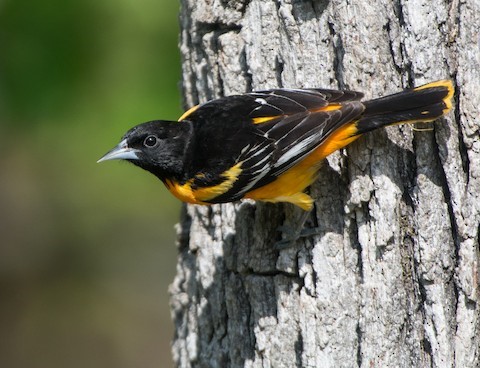
Baltimore Oriole, male. (Big Rock Township, Arkansas; April 30, 2018.) © Susan Williamson

Baltimore Oriole, male. (Ludlow, Vermont; May 9, 2019.) © Michael Foster
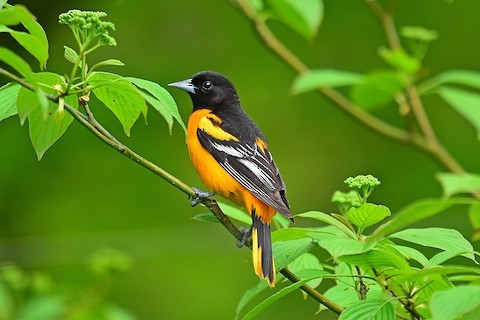
Baltimore Oriole, male. (Maribel, Wisconsin; May 24, 2017.) © Joel Trick
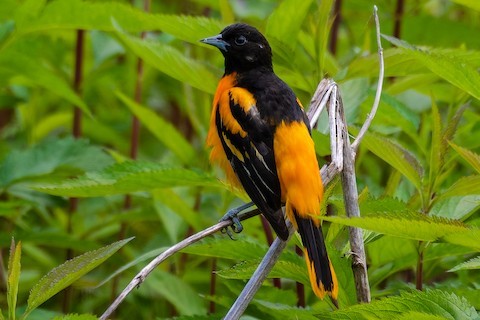
Baltimore Oriole, male. (Sandy Ridge Reservation, Lorain County, Ohio; June 4, 20198.) © Don Danko
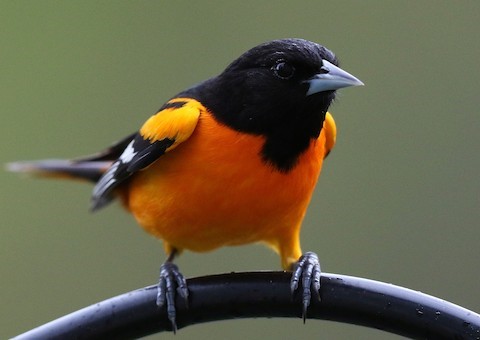
Baltimore Oriole, male. (Oswego, New York; May 1, 2017.) © Matthew Brown
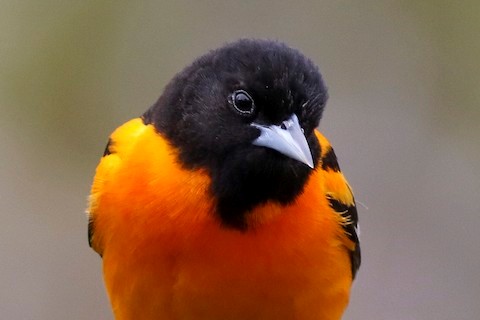
Baltimore Oriole, male. (Whitby, Ontario; May 16, 2017.) © Charmaine Anderson
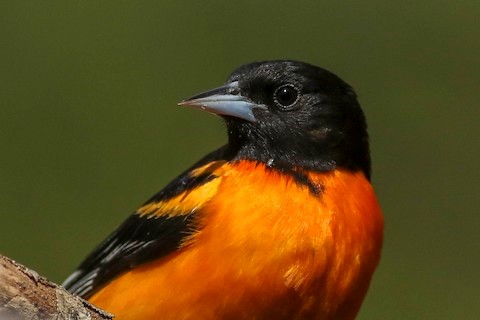
Baltimore Oriole, male. (Whitby, Ontario; May 11, 2018.) © Charmaine Anderson
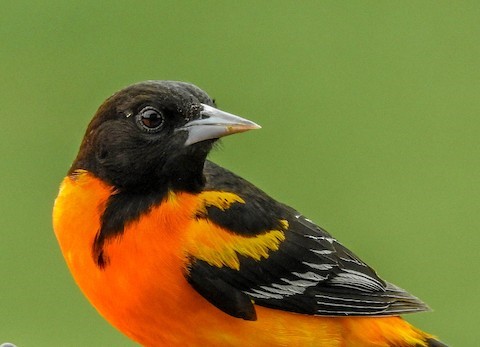
Baltimore Oriole, male. (Tamarack Lane, Bruce Township, Michigan; May 5, 2020.) © Christine Andrews
Other plumages are less distinctive and more variable. All typically have blackish wings with two whitish wingbars.
Typical female plumage is largely dull-orange above and below, except that the back is grayish-olive with blackish spots.
In spring, most females show some blackish spots on the head—in some cases a nearly complete black hood as on an adult male.

Baltimore Oriole, female. (Laguna Madre Trail, South Padre Island, Texas; May 4, 2019.) © Jason Massey
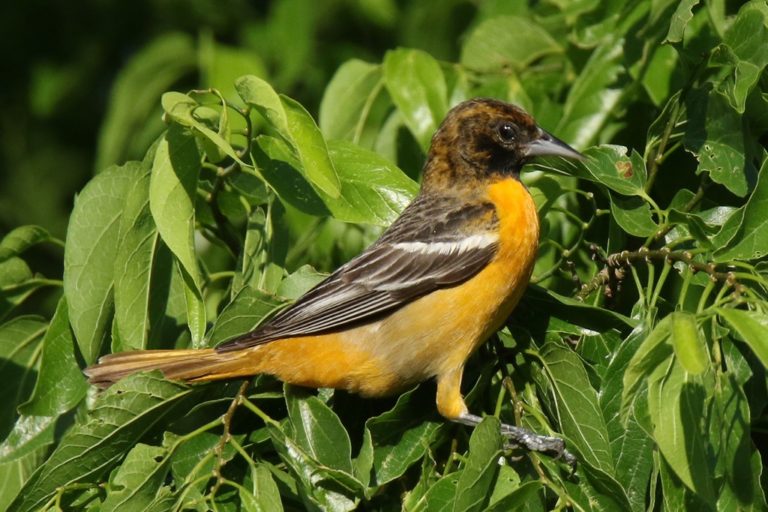
Baltimore Oriole, female. (Ellis County, Texas; May 6, 2018.) © fiddleman

Baltimore Oriole, female. (Boston Public Garden, Massachusetts; May 11, 2011.) © Ryan Schain
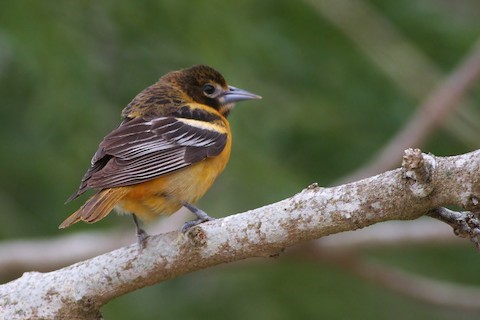
Baltimore Oriole, female. (South Padre Island, Texas; April 23, 2017.) © Alex Lamoreaux
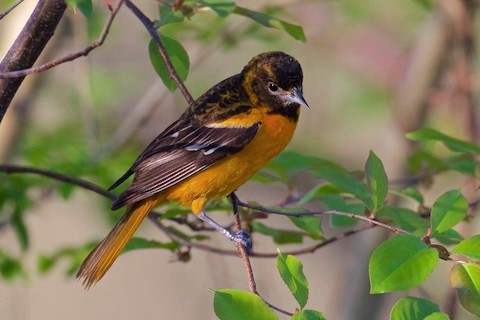
Baltimore Oriole, dark female. (Stu Visser Trails, Holland, Michigan; May 17, 2018.) © Dave Allen
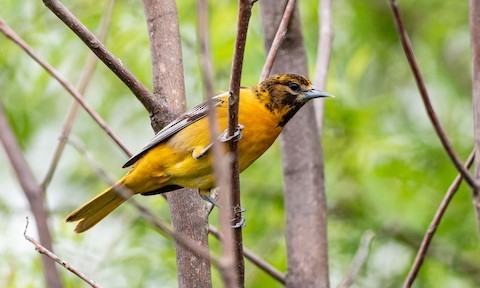
Baltimore Oriole, female. (Swan Harbor Farm, Havre de Grace, Maryland; May 27, 2020.) © Brad Heath

Baltimore Oriole, female. (Niles, Illinois; May 11, 2018.) © Heather Mall
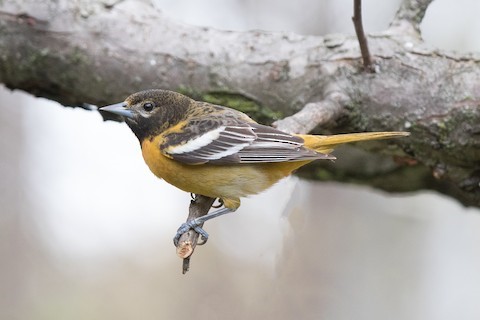
Baltimore Oriole, female. (Brown County, Wisconsin; May 16, 2019.) © Jane Benson
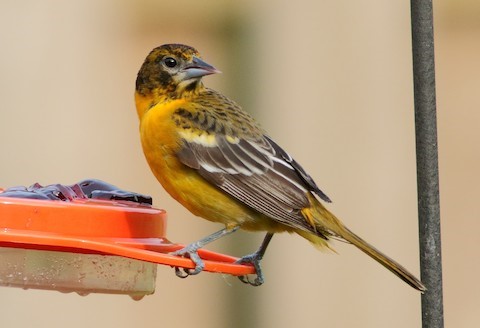
Baltimore Oriole, female. (Worthington Hills, Columbus, Ohio; June 2, 2019.) © Stephen Altic
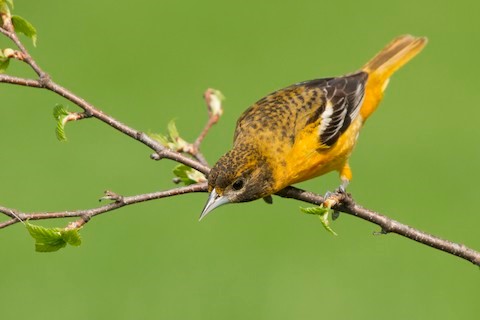
Baltimore Oriole, female. (Nicollet County, Minnesota; May 10, 2011.) © Bob Dunlap

Baltimore Oriole, female. (Mirador San Fernando, Alajuela, Costa Rica; November 28, 2014.) © Ilya Povalyaev
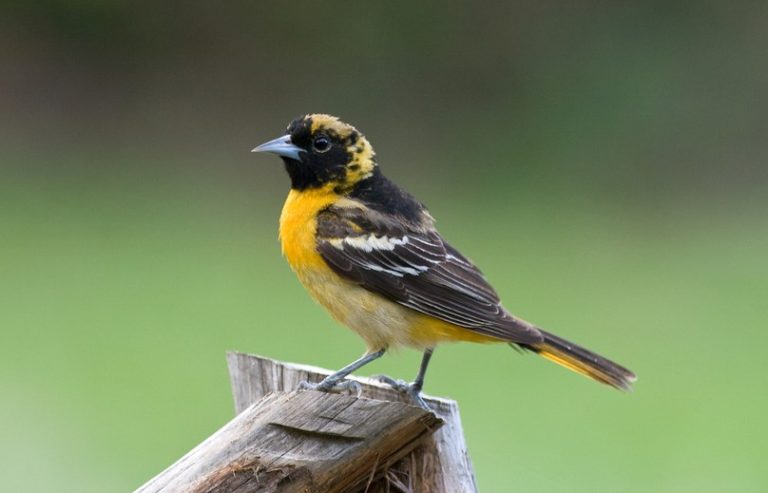
Baltimore Oriole, female. (Smith County, Texas; May 4, 2009.) © mikeintyler
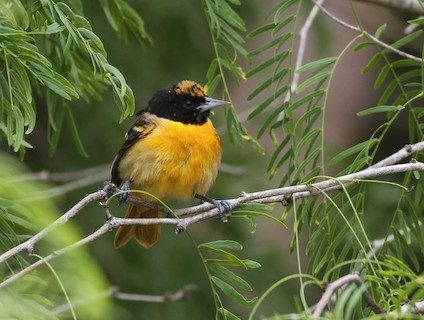
Baltimore Oriole, dark female. (South Padre Island, Texas; April 23, 2017.) © Alex Lamoreaux

Baltimore Oriole, female. (King Ferry, New York; June 24, 2019.) © Barbara Clise
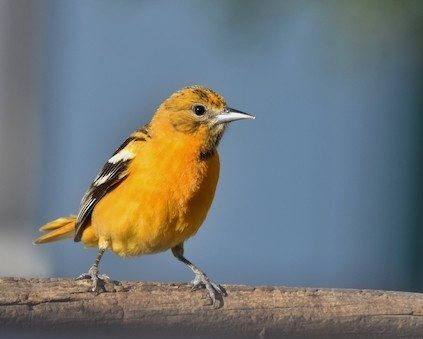
Baltimore Oriole, female. (Shelby County, Iowa; May 29, 2017.) © Marky Mutchler
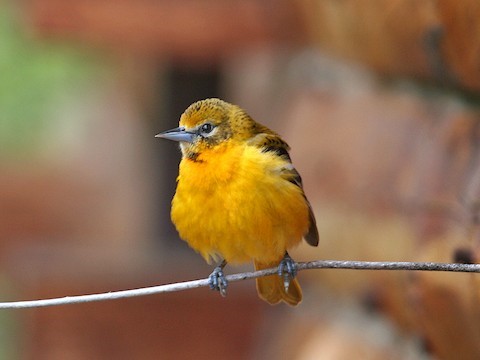
Baltimore Oriole, female. (Akers Pond, Errol, New Hampshire; May 16, 2006.) © Dick Dionne
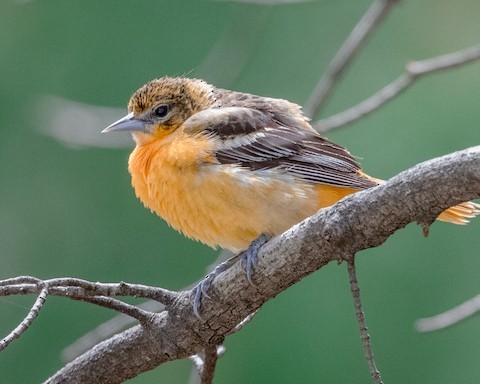
Baltimore Oriole, female. (Ludlow, Vermont; May 9, 2019.) © Michael Foster
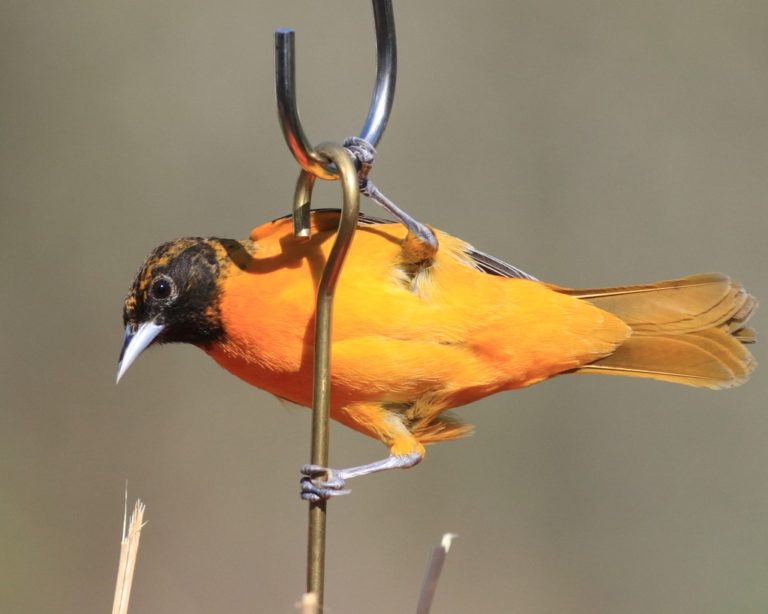
Baltimore Oriole, female at the dark end of the spectrum. (Norwich, Vermont; May 18, 2020.) © Keri Charles
Immatures generally resemble females and are similarly variable in pattern and coloration, but tend to be duller and grayer overall and lack blackish markings on the head.
The bills of immatures tend to be mostly pinkish or bicolored: pinkish below and gray above.

Baltimore Oriole, immature. (Wilmington, North Carolina; January 5, 2018.) © Sam Cooper

Baltimore Oriole, immature. (Monhegan Island, Maine; October 2, 2018.) © Doug Hitchcox
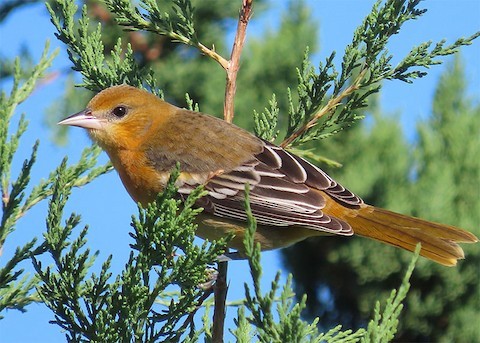
Baltimore Oriole, immature. (Wave, North Carolina; September 30, 2020.) © Karen Lebing
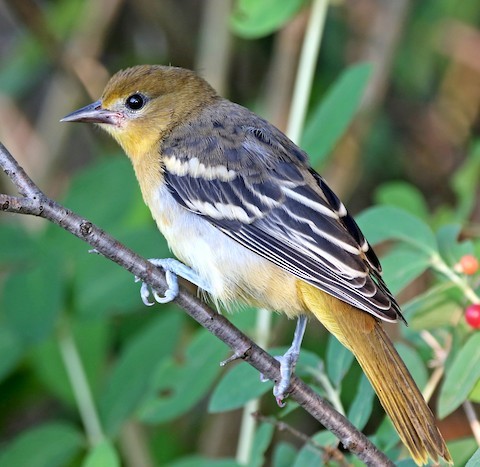
Baltimore Oriole, immature. (Boston Road, Angus, New York; July 7, 2020.) © Bill Brown
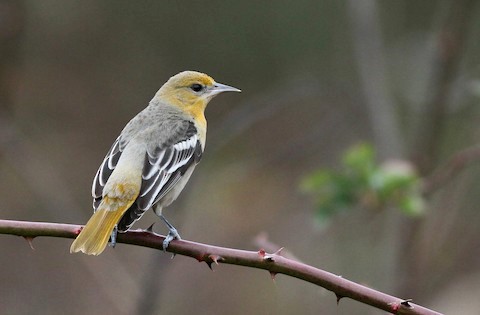
Baltimore Oriole, immature. (Fort Hill, Eastham, Massachusetts; November 24, 2011.) © Jeremiah Trimble
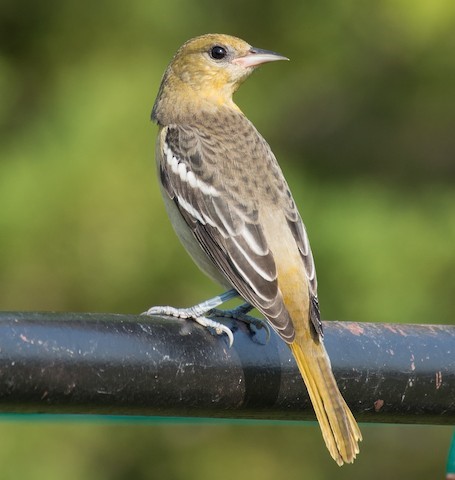
Baltimore Oriole, immature. (Rocky Ridge, Missouri; September 3, 2017.) © Jack and Shirley Foreman

Baltimore Oriole, immature. (Sydney, Nova Scotia; November 26, 2018.) © Steven McGrath

Baltimore Oriole, immature. (Alma, New Brunswick; December 18, 2020.) © Denis Doucet
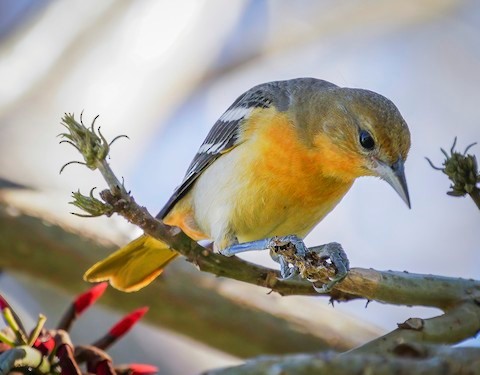
Baltimore Oriole, immature. (South Coast Botanic Garden, Los Angeles, California; January 1, 2021.) © Derek Hameister
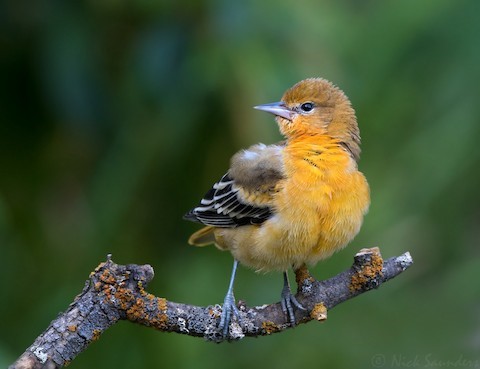
Baltimore Oriole, immature. (Saskatoon, Saskatchewan; August 16, 2019.) © Nick Saunders

Baltimore Oriole, immature. (Novi, Michigan; July 7, 2019.) © Darlene Friedman
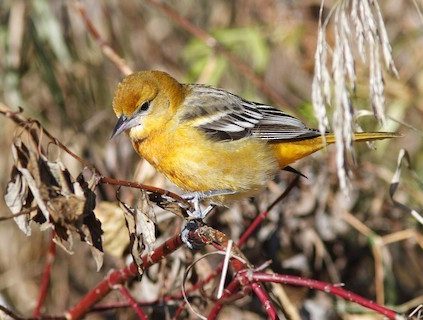
Baltimore Oriole, immature. (Cap Tourmente National Wildlife Area, Quebec; October 31, 2020.) © Serge Cloutier
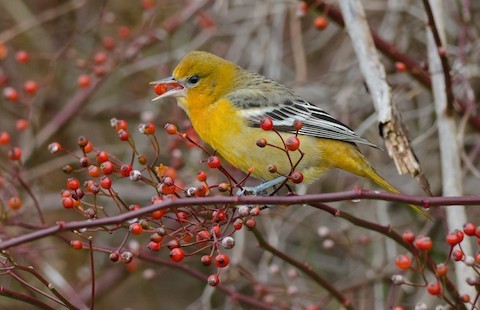
Baltimore Oriole, immature. (Tusket, Nova Scotia; November 30, 2020.) © Alix d’Entremont

Baltimore Oriole, immature. (Tusket, Nova Scotia; November 30, 2020.) © Alix d’Entremont
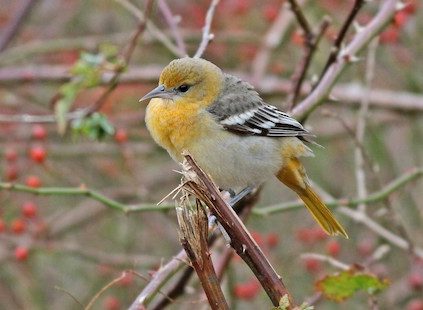
Baltimore Oriole, immature. (Fort Hill, Eastham, Massachusetts; November 24, 2011.) © Jeremiah Trimble
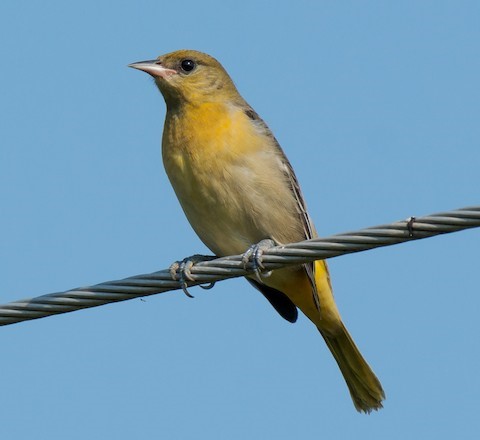
Baltimore Oriole, immature. (Rocky Ridge, Missouri; September 4, 2017.) © Jack and Shirley Foreman

Baltimore Oriole, male. (Peninsula Point, Michigan; May 18, 2016.) © Steve Kolbe

Baltimore Oriole, male. (Moraine State Park, Pennsylvania; May 5, 2020.) © Martin Carlin
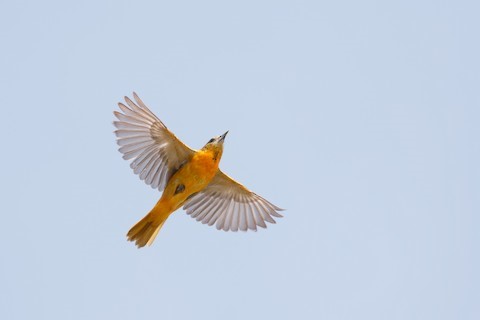
Baltimore Oriole, female. (Tawas Point State Park, Michigan; May 16, 2017.) © Steve Kolbe

Baltimore Oriole, female. (Tawas Point State Park, Michigan; May 18, 2017.) © Steve Kolbe
Cf. Bullock’s Oriole. Baltimore and Bullock’s Orioles were formally classified as conspecific (collectively known as the Northern Oriole) for two decades and have been known to interbreed in the Great Plains. Adult males are distinctive and unmistakable if seen well, but females and immatures of both are variable, and the plainest, palest, grayest immature Baltimore Orioles can strongly resemble female and immature Bullock’s.
Most borderline cases can be distinguished by comparing the brightness of the head and chest. Bullock’s typically shows more orange (or buffy or yellow) on the head than on the chest, whereas Baltimore is typically either brighter on the chest or about equally bright on the head and chest. Immature male Bullock’s are often recognizable by the presence of black on the throat (but not elsewhere on the head), so confusion is more likely with immature female plumages.
Cf. Black-backed Oriole. The Mexican endemic Black-backed Oriole has traditionally been regarded as conspecific with Bullock’s and for two decades also with the Baltimore Oriole, collectively known as the Northern Oriole. Adult male Black-backed is generally intermediate in appearance between Baltimore and Bullock’s, but distinctive in that its entire back and rump are black. Adult female Black-backed resembles immature male Bullock’s, as both typically have black on the throat, but not elsewhere on the head. Immature female Black-backed may not be reliably distinguishable from immature female Baltimore Oriole—except that Black-backed tends to show yellowish tones where Baltimore tends to show more orangish tones.
Cf. Streak-backed Oriole. Among several Neotropical oriole species that share habitat with Baltimore in winter, Streak-backed has special potential for confusion because of its streaked back—a feature it shares with female and immature Baltimores. Adults of both sexes differ from Baltimore in having a black mask and throat, but this coloration is not as distinct on immatures. A difference that applies to all age and sex classes is bill coloration: Streak-backed always has a predominantly blackish bill that is pale-gray on the basal half of the lower mandible.
Notes
Monotypic species. Formerly considered conspecific with Bullock’s (bullockii) and Black-backed (abeillei) Orioles, known collectively as the Northern Oriole (I. galbula).
References
Alderfer, J., and J.L. Dunn. 2014. National Geographic Complete Birds of North America (Second Edition). National Geographic Society, Washington, D.C.
Ascanio, D., G.A. Rodriguez, and R. Restall. 2017. Birds of Venezuela. Christopher Helm, London.
BirdLife International. 2018. Icterus galbula. The IUCN Red List of Threatened Species 2018: e.T22724126A132026652. https://dx.doi.org/10.2305/IUCN.UK.2018-2.RLTS.T22724126A132026652.en. (Accessed January 24, 2021.)
eBird. 2021. eBird: An online database of bird distribution and abundance. Cornell Lab of Ornithology, Ithaca, N.Y. http://www.ebird.org. (Accessed January 24, 2021.)
Fagan, J., and O. Komar. 2016. Peterson Field Guide to the Birds of Northern Central America. Houghton Mifflin Harcourt, New York.
ffrench, R. 2012. A Guide to the Birds of Trinidad & Tobago (Third Edition). Cornell University Press.
Garrigues, R., and R. Dean. 2014. The Birds of Costa Rica: A Field Guide (Second Edition). Cornell University Press.
Howell, S.N.G., and S. Webb. 1995. A Guide to the Birds of Mexico and Northern Central America. Oxford University Press.
Jaramillo, A., and P. Burke. 1999. New World Blackbirds: The Icterids. Princeton University Press, Princeton, N.J.
Kirwan, G.M., A. Levesque, M. Oberle, and C.J. Sharpe. 2019. Birds of the West Indies. Lynx Edicions, Barcelona.
McMullan, M., and T. Donegan. 2014, Field Guide to the Birds of Colombia (Second Edition). Fundación Proaves de Colombia, Bogotá.
Mullarney, K., L. Svensson, D. Zetterström, and P.J. Grant. 1999. Birds of Europe. Princeton University Press.
Raffaele, H., J. Wiley, O. Garrido, A. Keith, and J. Raffaele. 1998. A Guide to the Birds of the West Indies. Princeton University Press, Princeton, N.J.
Ridgely, R.S., and P.J. Greenfield. 2001. The Birds of Ecuador, Volume II: Field Guide. Cornell University Press.
Ridgely, R.S., and J.A. Gwynne. 1989. A Guide to the Birds of Panama (Second Edition). Princeton University Press.
Ridgely, R.S., and G. Tudor. 1989. The Birds of South America, Volume I: The Oscine Passerines. University of Texas Press.
Salt, W.R., and J.R. Salt. 1976. The Birds of Alberta. Hurtig Publishers, Edmonton, Alberta.
Sibley, D.A. 2000. The Sibley Guide to Birds. Alfred A. Knopf. New York.
Wells, J.V., and A.C. Wells. 2017. Birds of Aruba, Bonaire, and Curaçao. Cornell University Press.
Xeno-Canto. 2021. Baltimore Oriole – Icterus galbula. https://www.xeno-canto.org/species/Icterus-galbula. (Accessed January 24, 2021.)


